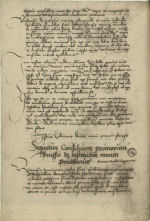
Monete cudende ratio - Essay on the Coinage of Money (1526)
[before April 1526]
Original: unknown.
Copies: Biblioteka Czartoryskich, Kraków, rkps 259, fol. 85v-91v; Geheimes Staatsarchiv Preussischer Kulturbesitz, Berlin, HBA, C. la Kasten 752, k. 2-6v; GStAPK, Ostpreussische Folianten, nr 12868, k. 41-49.
The third version of Copernicus' treatise on money entitled Monete cudende ratio (On the Coinage of Money) survives in three copies and was most probably written before April 1526. This revised version partly based on the text of his 1517 paper, was complemented by a general theory of money with special emphasis placed on the debasement of money as one of the main reasons for the fall of a state.
Copernicus was the first to explain the reason for the decrease in the value of money caused by gold and silver coins being made into an alloy with copper in the minting process. He also presented quite a detailed analysis of the debasement process in relation to Prussian coinage, referring to how the good coinage issued by the Teutonic State gradually decreased in value in the aftermath of the Battle of Grunwald (Tannenberg). In this version of his treatise Copernicus also added a new passage in which he stated that the relation between the nominal price (face value) of silver and gold coins should be identical with the price of pure silver and gold. Concluding his paper the author presented the main principles of the monetary reform to be effected in Royal and Ducal Prussia which he summarized in the following six points:
The reform should be introduced pursuant to a unanimous resolution and preceded by exhaustive deliberations;
There should be only one mint for the whole country
The former coinage should be withdrawn the moment new currency is put into circulation;
20 twenty-groshen grzywnas should be made of one pound weight of pure silver bullion - which would lead to equivalence between Prussian and Polish coinage;
Coins should not be issued in large quantities;
All kinds of new coins should be put into circulation simultaneously.
An analysis of Copernicus general views on monetary issues show that he was a follower of the metallist theory of money; he saw the source of the value of a coin in its metal content. For him a coin was a marked (stamped) piece of gold or silver which is used as payment for commodities being bought or sold according to the legal tender laws passed by the issuer, namely the state or the ruler. According to Copernicus all kinds of money have their value (valor) and their estimated value (estimatio); while the value of a given coin depends on the amount and quality of the metal bullion of which it is made, its estimatio is its nominal value set by the overall authority in the country.
A good coin should show no difference between its nominal value and the actual value of the material it has been minted from. Copernicus defined different functions for money seeing it as a measure of value, a necessary medium of exchange (for payment or purchase) and of savings. The most important for the advancement of economics, however, is his law of bad money known as Greshams or Copernicus-Greshams Law. Copernicus formulated this law inter alia in the third draft of his treatise on money: when new worse money is introduced while the former better money has remained in circulation, the bad not only infects the good but, as it were, drives it out of circulation.
Nicolaus Copernicus University
